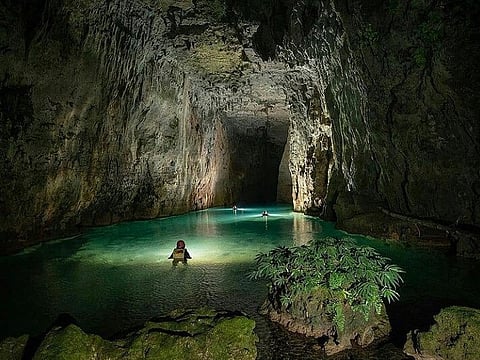
- Destinations
- Experiences
- Stay
- What's new
- Editor’s Picks
- Responsible Tourism
- CampaignsCampaigns
- Subscribe

Meghalaya is home to a large subterranean ecosystem. Out of the 10 longest and deepest caves found in India, the top nine are in this northeastern state alone. One of these is the 20.4km-long Krem Chympe, the fifth-longest cave under the Jaintia Hills. Its intricate passages, unique limestone formations and rich biodiversity are a natural wonder, making it an excellent offbeat destination for anyone who enjoys spelunking.
Here’s what you should know about the Krem Chympe cave system.
Complex geological processes that shaped the region over millions of years gave rise to the Krem Chympe cave system. The cave passages were carved by water flowing over the limestone rocks over countless centuries. This also led to the formation of some 50 natural dams along the main river passage, some of which are 12m high.
When you reach the cave, you will notice that the entrance is framed by imposing limestone cliffs adorned with lush vegetation. To enter, you will either need to swim or embark on a canoe or bamboo raft as the water levels in the cave can rise as high as 6-7.9m.
Inside, the crystal-clear waters of the 3.5km-long river and the smooth calcite formations hidden beneath the vegetation reveal themselves. The stalactites and stalagmites look like frozen waterfalls while the colours range from dark earthy tones to shimmering golds and whites. Among the vast network of interconnected caves that make up Krem Chympe, the largest is the "Golden Orchid Chamber." Its golden-hued stalactites and stalagmites resemble a field of flowers in the torchlight.
One of the unique aspects of Krem Chympe is its natural dams known as gours. These are formed by the high concentration of calcium carbonate in the cave water and are a testament to the delicate balance between water and stone over thousands of years.
The cave's unique environment supports a fragile ecosystem. Bats find refuge within the cave, their guano providing nourishment for other creatures that call this subterranean realm home. The aquamarine water reveals a hidden world of aquatic life, where fish and other organisms thrive. In fact, the world’s largest cavefish was discovered here in 2020 by scientists—the biggest specimen they found was longer than 40cm. There are also crickets, birds and spiders that live here. Explorers who have descended into its depths describe it as a place of breathtaking beauty and enigma.
According to Brian D Kharpran Daly, the general secretary at the Meghalaya Adventurers' Association, visitors should go with a proper guide if they want to take full advantage of the experiences Krem Chympe offers. "It is a huge river cave with about 4km of swimming section over deep lakes. Use lifejackets to swim and enjoy the magnificent cave with huge colony of bats and [a] fantastic collection of formations," he says. Travellers can also canoe on the vast lakes, take photographs of the awe-inspiring rock formations, go deep into the cave’s labyrinthine corridors with a spelunking expedition, take a nature walk in the exterior of the cave and camp outdoors at night to see the stars come out.
This waterfall is a sight to behold. You can find every shade of green here, from the verdant trees to the mossy rocks, culminating in the tranquil pool below. The cascade sprays delicate droplets that shimmer in the daylight. Beyond its visual appeal, the inviting emerald pool beckons for a rejuvenating dive. While you’re here, sip tea from bamboo cups and let the gentle roar of the falls in the background bring peace to your heart.
This hidden gem is steadily becoming a well-known tourist attraction. Take a shower under the multiple cascading levels and swim in the pool at the foot of the waterfall.
Meandering gracefully through the landscape, the river’s serene waters reflect the sky above. A little further on, the silhouette of a hanging bridge stretches across it—the juxtaposition of the tranquil river and the distant bridge is a beautiful scene. Sadly, large-scale coal and limestone mining has polluted the river and threatens its marine habitats. Be mindful of your impact when you visit the area by not littering or throwing trash into the Wah Lukha.
This forest is one of the few places in the world where lush multi-storied primary forests are still intact. Underneath the top storey of tall trees, you will find the luxuriant growth of epiphytes, mosses and ferns. The floor of this forest is also covered with a thick layer of moist humus. At least 41 species of mammals, 15 species of bats and more than 400 species of birds have been found in this region.
To ensure long-term conservation and scientific management of the wildlife and their habitat, a part of the Narpuh Reserve Forest was notified as a wildlife sanctuary in 2014. The sanctuary is spread across 59.90 square kilometres and is home to several rare, endangered and endemic species of flora and fauna, including the hoolock gibbon, serow, slow loris, rufous-throated partridge, oriental pied hornbill and leopards.
The rich flora and fauna of the sanctuary is under immense pressure as the diversity of wild animals attracts several poachers. Except for an entry point at Sonapur, the entire sanctuary is inaccessible to vehicles and can be explored only on a boat or by trekking along inhospitable and rugged terrain.
